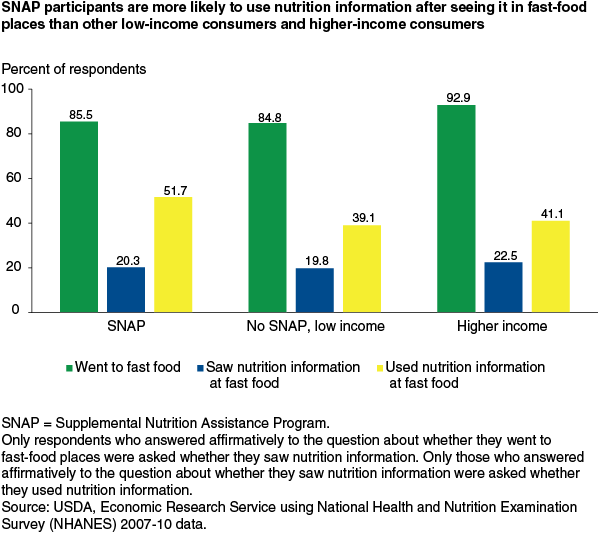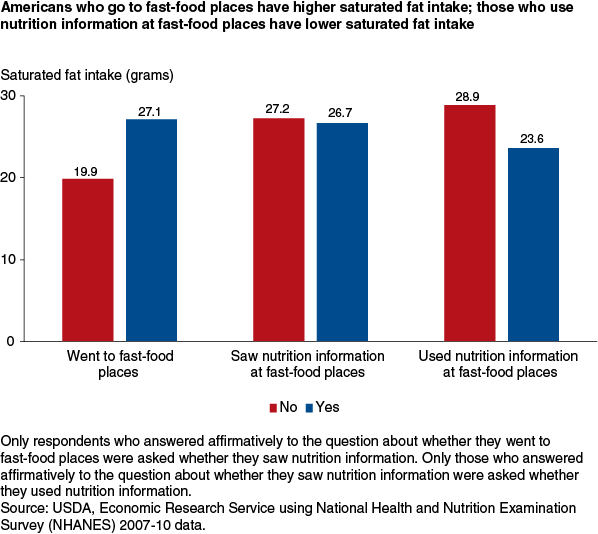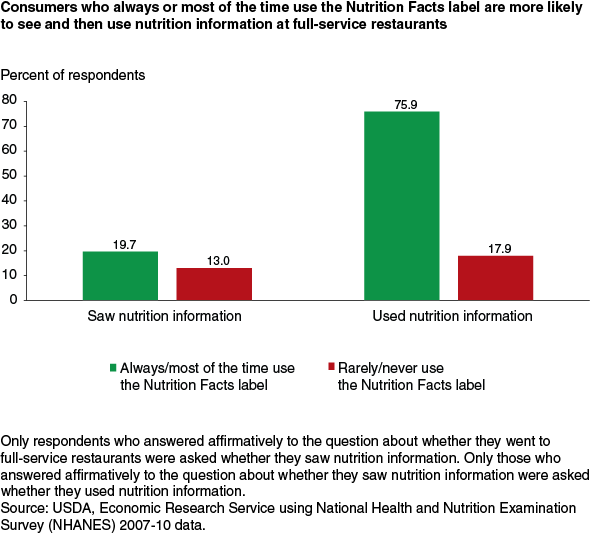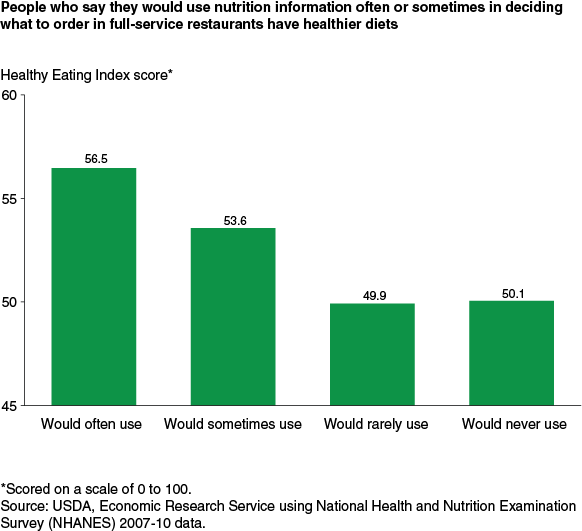Calorie Labeling on Restaurant Menus—Who Is Likely to Use It?
- by Christian A. Gregory, Ilya Rahkovsky and Tobenna D. Anekwe
- 9/8/2014
Highlights
- Only 8 percent of U.S. consumers say they use nutrition information to make their selections when eating at full-service restaurants or fast-food places.
- Consumers who eat at fast-food places three or more times per week are less likely to use nutrition information when eating out.
- Consumers who engage in healthy diet behaviors at home—such as consulting Nutrition Facts labels on grocery store foods or keeping dark green vegetables in their refrigerators, freezers, or pantry shelves—are more likely to use nutrition information when eating out.
One strategy for helping Americans improve their diets is to provide consumers with nutrition information when they make their food choices. While grocery stores with packaged foods are required to list per serving amounts of calories and a variety of nutrients, food away from home (FAFH) has not been subject to the same nutrition-labeling requirements. Some eating places voluntarily provide nutrition information and some local governments have FAFH calorie labeling laws, but no national regulations are in place.
In response to this issue, the 2010 Patient Protection and Affordable Care Act (ACA) includes provisions requiring all chain restaurants with 20 or more locations to provide calorie information on menus. Information on other nutrients—fat, saturated fat, cholesterol, sodium, total carbohydrates, sugars, fiber, and total protein—would have to be available in written format on request. The U.S. Food and Drug Administration is finalizing regulations to implement these provisions of the law.
Given these changes, ERS researchers decided to examine consumers’ use of nutrition information that eating establishments already provide voluntarily. Researchers examined the demographics and diet-related behaviors of people who already use nutrition information when eating out and people who say they would use such information if it were available. Researchers also explored whether more nutrition information for FAFH would prompt the average consumer to make healthier choices. The study establishes a baseline against which to measure changes in behavior after the law is implemented and provides information that could be useful for developing future nutrition information and education policies.
Consumers Were Asked About Their Awareness and Use of Nutrition Information
ERS researchers used data from the 2007-08 and 2009-10 Flexible Consumer Behavior Survey (FCBS) module of the National Health and Nutrition Examination Survey (NHANES) to examine the demographic and health-related characteristics of consumers who use nutrition information away from home. FCBS asks consumers about their food shopping and spending habits, self-perceived diet quality, familiarity with Federal dietary guidance, and use of nutrition or health information.
In particular, the survey asks three key questions about eating out and use of nutrition information. First, it asks whether the respondent has eaten away from home in the last 12 months. Second, respondents who respond affirmatively are asked whether they saw nutrition information on the menu during their most recent trip to eat out. Finally, respondents who saw nutrition information on the menu are asked whether they used it in choosing what to order. At the time of the surveys, most nutrition information was voluntarily provided and was not available at all eating places. A 2010 survey of the 400 largest U.S. restaurant chains found that 61 percent provided calorie information for the majority of their standard menu items.
The short answer to the question, “Who eats out?” is “Just about everyone.” Ninety percent of Americans reported that they had gone to fast food/pizza places and 88 percent to full-service restaurants in the previous 12 months. Few of these respondents saw nutrition information: 21 percent of fast-food patrons and 17 percent of full-service restaurant patrons saw nutrition information on menus. Of those who saw nutrition information on the menus, 42 percent of fast-food patrons and 55 percent of full-service restaurant patrons said they used this information. Because few consumers saw nutrition information while eating out, the total share of patrons of both fast-food and full-service restaurant establishments who used nutrition information was only 8 percent.
Nutrition Information Use Varies by Demographics
Researchers found interesting differences in use of nutrition information across population subgroups. For example, men and women are about equally likely to go to fast-food places and full-service restaurants. In terms of seeing nutrition information, there was no gender difference in fast-food places but there was in full-service restaurants. In full-service restaurants, 14 percent of men versus 20 percent of women saw the information. Additionally, women are much more likely than men to use the information in either context (49 percent of women versus 33 percent of men for fast food; 60 percent of women versus 48 percent of men for full-service restaurants). This gender difference may be related to other research that has found that men are less likely than women to believe that nutrition information is useful and that reading food labels makes it easier to choose foods.
Hispanics are less likely than Whites to go to fast-food places, while Hispanics and Blacks are much less likely than Whites or people of other races to go to full-service restaurants. Hispanics are also the least likely of all racial/ethnic groups to notice nutrition information on menus at full-service restaurants: Hispanics are 5, 10, and 2.5 percentage points less likely to see this information than Whites, Blacks, and those of other racial backgrounds, respectively. However, Hispanics who saw the information are much more likely than Whites to use it in fast-food places and are the most likely of all racial backgrounds, by a large margin, to use it in full-service restaurants. For example, 73 percent of Hispanics who saw nutrition information said they used it when choosing what to order in a full-service restaurant, compared to 53 percent of Whites, 57 percent of Blacks, and 61 percent of people of other racial backgrounds.
Finally, participants in USDA’s Supplemental Nutrition Assistance Program (SNAP) and low-income nonparticipants are less likely to go to fast-food places or full-service restaurants than are higher income people. The share of SNAP participants and low-income nonparticipants who say that they ate at fast-food places during the previous 12 months is about 85 percent, compared with 93 percent of higher income people; at the same time, 64 percent of SNAP participants say that they ate at full-service restaurants, compared with 77 percent of low-income non-participants and 94 percent of those with higher incomes. All three groups are about equally likely to notice nutrition information on fast-food menus. However, upon seeing the information, SNAP participants are much more likely to use information in a fast-food setting (52 percent) than higher income people (41 percent) and low-income nonparticipants (39 percent).
Consumers Who Value Health More Likely to Use Nutrition Information
Researchers found important differences between the users and non-users of FAFH nutritional information related to diet quality and behavior. Those who said they used nutrition information at full-service restaurants and fast-food places had Healthy Eating Index (HEI) scores that were an average of 7 and 6 points, respectively, higher than those who did not. (The HEI measures a person’s adherence to dietary recommendations in the Dietary Guidelines for Americans and is scored on a scale of 0 to 100.) Consumers who do not use nutrition information when they see it at fast-food places have higher daily intakes of saturated fat (29 grams versus 24 grams) than those who use the information. Similarly, consumers who use nutrition information at full-service restaurants consume about 7 grams less saturated fat per day than those who do not.
In addition to diet quality, researchers looked at dietary behavior. Respondents were asked how many times per week they eat food away from home in general and fast food specifically. Survey responses reveal that people who eat out frequently are less likely to use nutrition information in making their choices than occasional patrons. For example, consumers who eat fast-food meals more than five times per week are about 29 percent less likely to use the information when they see it than people who eat two or fewer fast-food meals per week (31 percent versus 44 percent). Possibly, consumers who frequently eat out are already familiar with the nutrition information provided, and therefore do not use it, or, alternatively, they may be just less inclined toward a healthy diet.
Respondents were asked how often they stored certain kinds of food in their homes—such as salty snacks, fruits, and dark green vegetables. The available responses were “always,” “most of the time,” “sometimes,” “rarely,” and “never.” People who rarely or never had dark green vegetables at home were as likely to go to full-service restaurants as people who always or most of the time have the vegetables but were less likely to see nutrition information on full-service restaurant menus. This “rarely or never” group was also 35 percentage points less likely to use nutrition information on full-service restaurant menus than the “always or most of the time” group.
Finally, the frequency with which respondents consult the Nutrition Facts label on store-bought foods is also strongly related to their use of nutrition information at full-service restaurants. Those who always or most of the time use the Nutrition Facts label are more likely to use full-service restaurant nutrition information than those who use the Nutrition Facts label rarely or never.
Who Would Use Nutrition Information If It Were More Widely Available?
The FCBS phone follow-up module also asks respondents who have been to an eating establishment in the last 12 months how often they would use nutrition or health information in fast-food places and full-service restaurants if it were available. Response options were “often,” “sometimes,” “rarely,” and “never.” As with actual use of nutrition information, researchers found a strong relationship between dietary habits and people’s assessments of how frequently they would use nutrition information.
For example, having used nutrition information in the past is positively correlated with stated willingness to use it in the future. Among individuals who have used nutrition information on fast-food menus in the past, 92 percent say they would “often” or “sometimes” use nutrition information at fast-food places in the future; the corresponding share for full-service restaurants is 96 percent. A person’s HEI score was also found to correlate strongly with declared willingness to use nutrition information in FAFH establishments. People who say that they would use nutrition information “often” in both fast-food and full-service settings have the highest average HEI scores, followed by those who say they would use it “sometimes.” Among full-service restaurant patrons, both the “often” and “sometimes” groups have significantly higher HEI scores than the “rarely” and “never” groups. In the context of fast food, those who say they would use nutrition information “often” have significantly higher HEI scores than all other respondents, and the “sometimes” group has a higher HEI score than the “never” group.
Looking Ahead
A key assumption behind the push to provide consumers with nutrition information—as mandated by the ACA—is that consumers will use the information to improve their diets. In this study, researchers found that diets of consumers who use nutritional information are markedly better than the diets of the consumers who do not use it. Similarly, consumers who engaged in healthy eating behaviors express more willingness to use nutritional information in the future than consumers who do not. This may imply that consumers who already use labels in supermarkets and follow healthy diets will be more likely to use nutrition information in restaurants once restaurants are required to display it.
If this is true, it implies that consumers who already have healthful diets may be more likely to benefit from the new FAFH labeling requirements and that mere exposure to nutrition information may not be enough to motivate those who do not have healthful diets. Thus, it may be too optimistic to expect that, after implementation of the nutrition disclosure law, consumers who have not previously used nutrition information or have shown little desire to use it in the future will adopt healthier diets. One concern, then, about the labeling mandate is whether it will increase nutrition and health disparities between those who currently use nutrition information while grocery shopping and eating out and those who do not use it. If this is the case, then further work on how best to increase the use of nutrition information and dietary health among people with subpar diets is critical.
This article is drawn from:
- Gregory, C.A., Rahkovsky, I. & Anekwe, T.D. (2014). Consumers' Use of Nutrition Information When Eating Out. U.S. Department of Agriculture, Economic Research Service. EIB-127.






